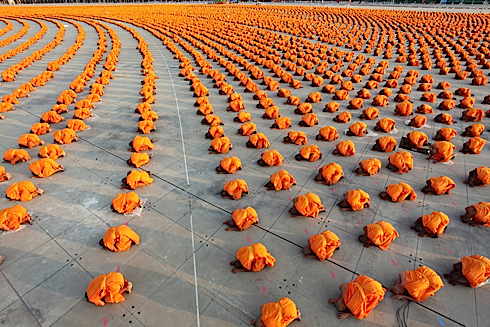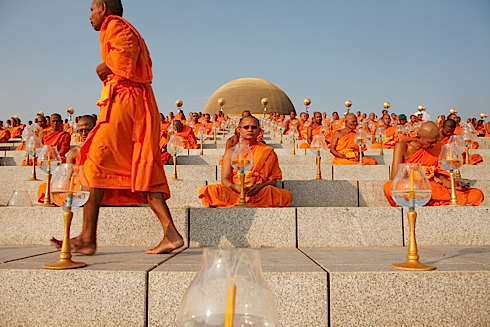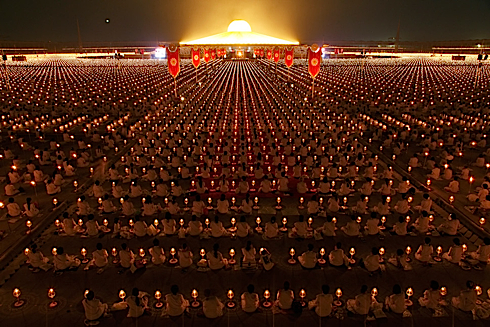Emergent Religions
One of the biggest surprises in the last century has been that new religions continue to emerge in modern societies. This was not suppose to happen. By the year 2000 everything was supposed to be rational and logical. And yet religions continue to emerge all around the world. In particular, as Asia modernizes, gets wealthy, and integrates with many Western values, it will continue to witness the emergence of wholly new religions, in varieties unknown to date.
Exhibit A might be the Eastern Lightening church in China, who believe a plain-looking women from Henan is the third coming of God. She has tens of thousands of followers willing to go to jail to follow her. Or it could be the new religion Dhammakaya, based in Thailand. In fact, the Dhammakaya community is not that new, but its sudden explosive growth and new found prosperity is. While many religions try to keep to themselves, Dhammakaya favors huge spectacles. They present massive gatherings which flaunt impeccable precision. Rather than the churning chaos of India’s Kumbha Mela or Nevada’s Burning Man, think of an awesome North Korean Great Leader spectacle, or the machine precision of the recent Chinese Olympics. But with lots of silence.
An article in Foreign Policy called Close Encounters of the Buddhist Kind supplies photos and captions of the congregation:

In what was promoted as the largest gathering of its kind in history, the Upasika Kaew culminated with a mass meditation with a claimed attendance of 1 million women. An estimate of 100,000 to 200,000 actually attended, but thousands more watched on the Dhammakaya’s satellite network and joined in on the meditation at over 100 centers around the globe.

While Dhammakaya is now four decades old, only in recent years has it scaled up to such spectacles — a two-week nationwide retreat culminated on Dec. 25, 2010, in what some likened to a Buddhist Woodstock, with a target of 1 million women participating in a mass meditation, the Upasika Kaew. In August 2009, as seen here, an ordination was held for a more modest gathering of 12,000 monks.

Despite outlandish ceremonies and its own television coverage of these events, Dhammakaya has remained mainly under the world’s radar. Yet, in Thailand, opinion is loud and extreme — people either adore Dhammakaya or are caustically critical of what is widely feared to be a cult. Mano Mettanando Laohavanich, a renowned Buddhist scholar who was once among the top Dhammakaya leaders, heading its entire American operations, has become a rabid critic since leaving the temple. He called Dhammakaya’s rapid growth and mass ceremonies “power trips” inspired by the head abbot’s fascination with the Muslim hajj gatherings and Nazi parades.

These parades are a show of power and modernity in an ancient land crowded with tradition-bound religions. Its appeal is to the educated, and new urbanites. Note the flying saucer mother ship at the center of their ritual. Who doesn’t want to move the future in that?
Most new religions, in Asia, Africa, Russia, and the Americas are not as flamboyant. But they are there. No one has counted how many in the developing world, but there are about 1,000 in the US and another 1,000 in Europe. It’s almost a full time job keeping up with the brand new ones.
J Gordon Melton is one of the veteran pioneers studying new religions, at first new religions in the US, and then worldwide. In summarizing what he has learned in 40 years of looking at emerging religions he said:
Almost all New Religious centers are found in urban/suburban complexes…New religions direct their recruitment efforts toward one of two main groups, the 18 to 25-year-old young adult and the 35-40-year-old middle-age adult… The majority of recruits to New Religions will be persons in personal transition, either the transition from adolescence to adulthood, or the transition often called the mid-life crisis…Continued attempts have been made to locate some pathology either in the process of selection of people who join New Religions, or in those who are members. To date, no evidence of abnormal psychological pathology or significant deviation from the cultural patterns psychologically has been documented in the New Religions.
They are normal people, or at least as normal as people in old religions. Every historical religion began as a cult or sect. As religion scholar Peter Jenkins says, “Fringe religions became mainstream churches, and ideas which originate several leagues beyond flaky can easily become orthodoxy.” The cults, sects and weird new religions of today will be the stuffy, stagnant proper religions of tomorrow.
There’s not a lot else new religions have in common with each other, other than being new. Melton continues:
Like older religions, New Religions may be culture-affirming or culture-denying. New Religions vary from the strongly hierarchical to the anarchic. Some New Religions subordinate women while others champion women’s rights. Some NRMs are family oriented, other undermine the family at every turn. Some groups emphasize spiritual practices, other reject any need for them. Some groups are involved in making social policy, others want nothing to do with outsiders or secular social structures. Some groups are middle class and upwardly mobile, other reject any materialistic acquisitions….We have reached a general consensus that New Religions are genuine and valid religions. A few may be bad religion and some may be led by evil people, but they are religions. They are also interesting objects of study that tell us some significant facts about society as a whole (though we disagree and are exploring various options as to exactly what they tell us). However, we agree that the phenomena we have encountered in New Religions does not differ from the phenomena we have encountered in older religions and that in fact New Religions tend to copy and borrow from older religions and the culture at large.
Emergent religions are primarily reflections of society. They are a collective attempt to understand and make meaning. In places like China where there is currently a vacuum of meaning — no scriptures, no constitution, just the little red book of Mao, and rampant Darwinian pressure to make money — it should be no surprise that vehicles of something larger to believe in will appear. In Russia, a belief in science mixes with a resident mysticism producing new religions. In Africa, the dire lack of health care summons all kinds of new faith healing churches. And in the west, the need to make sense of technology and our own mutating human identity will breed new religions.
And a few of those future sects will want to put on a show.


